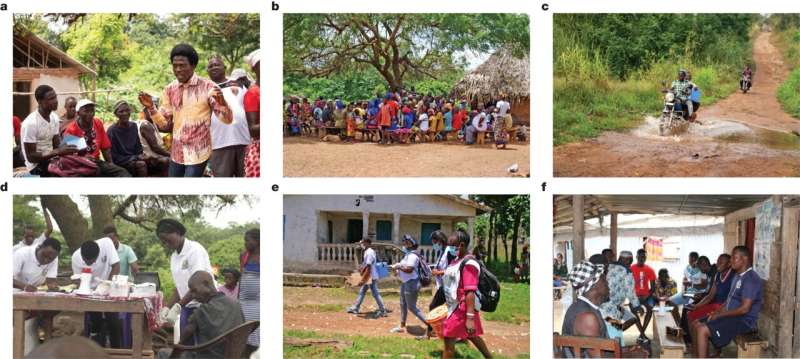This article has been reviewed according to Science X's editorial process and policies. Editors have highlighted the following attributes while ensuring the content's credibility:
fact-checked
peer-reviewed publication
trusted source
proofread
'Last mile' solutions shown to increase vaccination coverage in poor countries

The use of mobile clinics to deliver COVID-19 vaccines can significantly increase vaccination uptake. Research by Wageningen University & Research, conducted in rural communities in Sierra Leone and published today in Nature, shows that addressing "last mile" problems such as accessibility has a positive effect on vaccination rates.
The study, titled "Last-mile delivery increases vaccine uptake in Sierra Leone," was conducted in Sierra Leone in early 2022, a year after the rollout of the COVID-19 vaccine. At the time, only 6-9% of adults participating in the study had been vaccinated, a very low rate.
By comparison, the vaccination rate in the Netherlands was greater than 65% at that time. Sierra Leone, like many other poor countries, has a large number of people living in remote areas. For anyone living in those areas during the pandemic, obtaining a vaccine would have cost several hours and a week's wages. The researchers therefore worked with the Ministry of Health to see whether it would be helpful to bring mobile clinics to those remote areas, thereby removing those barriers.
Mobile vaccination sites
In partnership with Sierra Leone's Ministry of Health and the international NGO Concern Worldwide, the researchers conducted a randomized controlled trial with a little over 20,000 people in 150 rural villages just outside the national network of clinics (where vaccines were available). Teams from the ministry brought the vaccines to the remote villages and set up mobile vaccination sites there for two to three days.
A hundred villages were part of the randomized intervention group and 50 were in the control group. Within 48-72 hours, the vaccination coverage in the villages increased by 26 percentage points. Inhabitants of surrounding villages also came to get a vaccine, leading to a seven-fold increase in the number of vaccinated people. The government took on board lessons from this study to improve their campaign in rural areas. In December 2022, the country met the WHO vaccination target of 70%.
Distributing vaccines through these mobile clinics cost $33 per person. That's 76% cheaper than the average cost of other vaccination campaigns (about $80). This approach can therefore serve as an example for other developing countries with large rural populations in remote areas, because the need for transport to reach villages is what accounts for most of the costs in health care provision. The researchers therefore suggest that it would be efficient to use the same trips to provide other forms of health care, such as mother-and-child services.
Blueprint for campaigns
The study comes at a crucial time, with developing countries still recovering from the economic and health impact of COVID-19. A new problem is that resistance to standard vaccination campaigns (such as for HPV and MMR) seems to be increasing.
The study could play a valuable part in developing the necessary cost-effective approaches to increasing vaccination coverage. It provides a blueprint for policymakers, researchers and NGOs to optimize vaccination campaigns, thereby reducing costs and promoting sustainable and inclusive economic growth.
Lead researcher Maarten Voors said, "Our research shows that access was a major barrier for people during the COVID-19 vaccination campaign in remote areas of Sierra Leone. Access, along with other elements such as communication, is crucial to the achievement of vaccination equity in developing countries and will also be relevant to fighting malaria and other diseases."
More information: Niccolò F. Meriggi et al, Last-mile delivery increases vaccine uptake in Sierra Leone, Nature (2024). DOI: 10.1038/s41586-024-07158-w





















